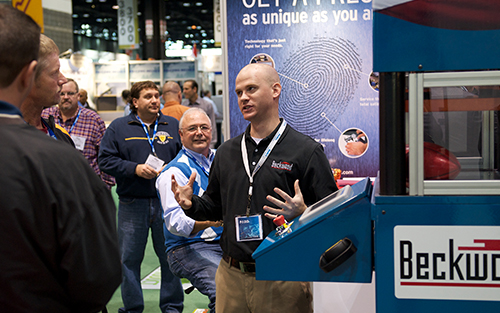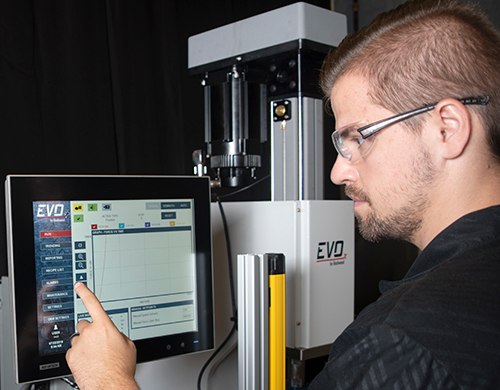MetalForming: What options are available to a metal former wanting to add machine intelligence to an existing press?
Dixon: The options for retrofitting machine intelligence into an existing press largely depend on the press’ configuration. If the majority of the machine's components are up-to-date, it is feasible to add machine intelligence with very few hardware modifications, focusing primarily on software. Older machines may require replacement of the entire hydraulic and/or control system to accommodate current software requirements. Either way, in most cases it is possible to achieve machine intelligence identical to that found on a new press.MetalForming: What other after-market features increase throughput?
Dixon: Aside from machine intelligence/monitoring used to eliminate unplanned downtime, hydraulic- and control-system retrofits can increase productivity. Hydraulic systems can be reconfigured or replaced to increase machine speed while, in many cases, still using the existing frame, cylinders and controls. By combining hydraulic and electrical rebuilds, older, inaccurate machines can achieve modern force and positional-accuracy tolerances with built-in go/no-go functionality, reducing scrap and ensuring that every finished part meets the required specifications.
MetalForming: What advantages do hydraulic presses offer over other equipment options?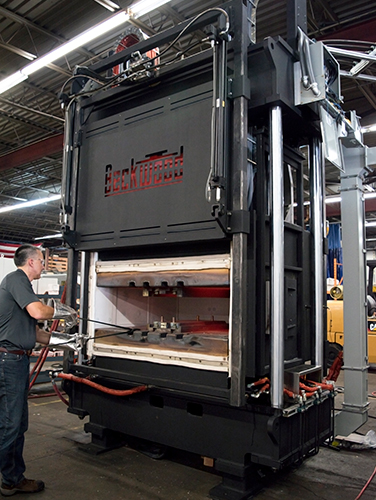
A 75-ton hydraulic press used to hot form titanium aerospace parts.
Dixon: Versatility and, in some cases, cost. We have the ability to customize nearly every aspect of a hydraulic press—bed size, tonnage, speed, daylight, stroke and more. For applications such as titanium hot forming, this is especially important because the speed at which titanium is formed directly impacts the finished part. The upfront cost, typically less than that of a standard servo-mechanical press, also is enticing.
MetalForming: You mentioned hot stamping and hot forming…what is the difference?
Dixon: During hot stamping, the workpiece—typically steel or aluminum—heats up to in excess of 1000 F in a furnace, automatically transfer into a press, and then is formed/ quenched in the die to increase the part’s overall strength. This process, most commonly used in the automotive industry, requires the use of a higher-speed press in order to make contact with the preheated workpiece before it cools.When hot forming, to make the material more malleable and reduce spring back after the part cools, the press, mated tooling and blank material heat to in excess of 1300 F inside of the press. Hot forming presses, most commonly used in the aerospace industry to form titanium and other high-strength alloys, travel much slower than hot stamping presses. Because no quenching occurs, the overall microstructure of the material does not change.
MetalForming: Are hydraulic presses for hot stamping or hot forming designed differently due to the heat generated by the process?Dixon: To protect the press’ structure from heat generated during the titanium hot forming process, hot forming presses typically feature 6- to 8-in.-thick ceramic insulation between the platens and cylinders as well as a water-chilled platen to dissipate the heat before it reaches the cylinder rods. Automated, insulated doors create a tight seal to efficiently contain the heat within the forming area and increase energy efficiency. Additionally, fire-retardant fluid is used in lieu of regular hydraulic fluid, fire sleeves protect hoses in certain areas, heat shields direct heat away from electrical components and air conditioning units cool the electrical cabinets. Everything ratchets up with high-heat applications. Heat transfer into the press frame and components is less of a concern in automotive hot stamping because typically, the part heats outside of the press and quenching occurs inside of the die.
MetalForming: Besides hot forming, what other applications are well suited for hydraulic presses? 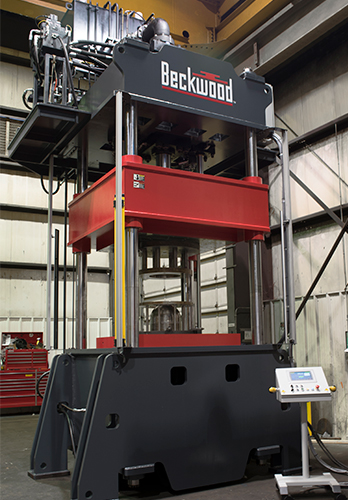
A 450-ton hydraulic deep draw press with dynamic bed cushion.
Dixon: Draw forming highlights the versatility of a hydraulic press. During a deep draw cycle, a stationary punch typically mounts on the press bed, with the blank material placed on a draw ring supported by the bed cushion. When the upper tool contacts the blank, the cushion, forced downward, forms the material over the punch. Press features such as Beckwood’s Dynamic Cushion Control allow for cushion tonnage adjustments throughout the entire draw process, giving the operator complete control over material flow to eliminate wrinkling and tearing. The ability to generate full force at any point throughout the stroke on both the main ram and the draw cushion gives hydraulic presses an advantage. Because mechanical presses only generate full tonnage at the bottom of the stroke, they are not ideal for this type of application.
MetalForming: What advice can you offer to metal formers seeking new production equipment?
Dixon: Application requirements often are the determining factor in machinery selection. For example, if a coil-fed application requires an output rate of 60 strokes/min. and the bed size and tonnage fit within the range for a standard mechanical or servo press, they may offer the best option. If not, a customized hydraulic press may be ideal. The end user must analyze application requirements for speed, force and positional accuracy before choosing a press.
With so much new technology, these are great but confusing times for companies considering press options. Discuss your application and production goals with several OEMs and choose the one that can tailor a solution to meet your exact needs. Try to consider not only what you need to satisfy current production requirements, but also what may be needed a few years down the road. Often, building ‘future-proofing’ features into a new machine up front, rather than trying to retrofit the same machine a few years later, saves money and time. MF
View Glossary of Metalforming Terms
See also: Beckwood Press Company
Technologies: Sensing/Electronics/IOT, Stamping Presses
Comments
Must be logged in to post a comment. Sign in or Create an Account
There are no comments posted. Stamping Presses
Stamping PressesBeckwood Press to Expand its HQ and Manufacturing Facility
Friday, April 25, 2025
Avoiding the 7 Deadly Sins of Stamping: Part 6; Using the 10...
Art Hedrick Friday, April 25, 2025
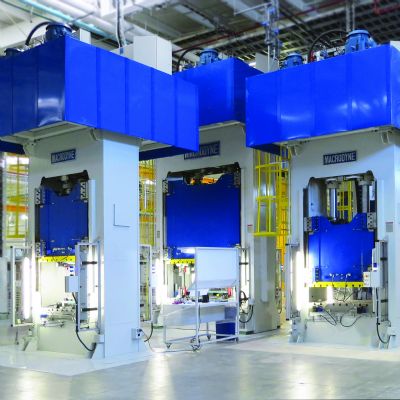 Stamping Presses
Stamping PressesHydraulic Press Innovations Move into Mainstream
Jeffrey Walsh Thursday, March 27, 2025
 Stamping Presses
Stamping PressesMidwest Press and Automation to Expand Manufacturing Operati...
Wednesday, March 26, 2025







